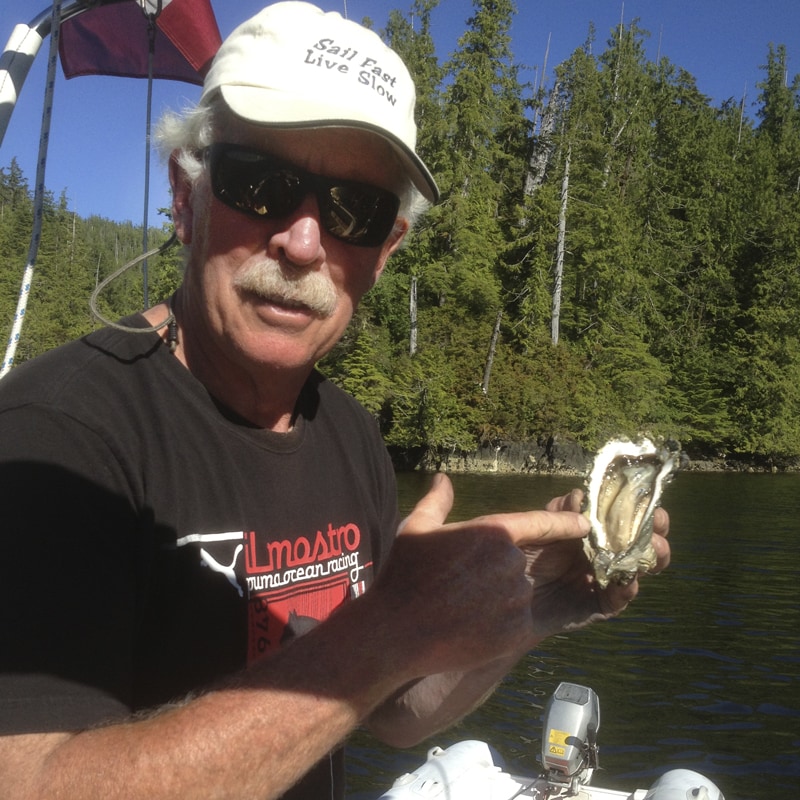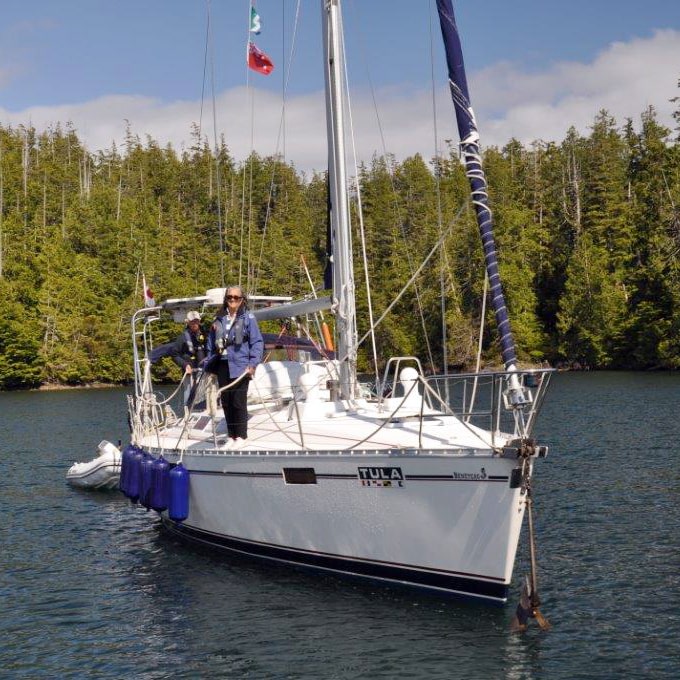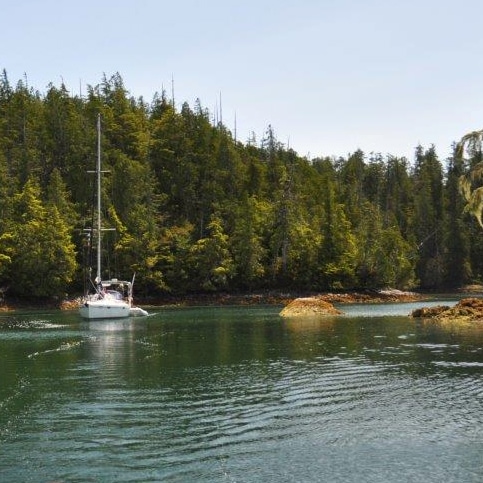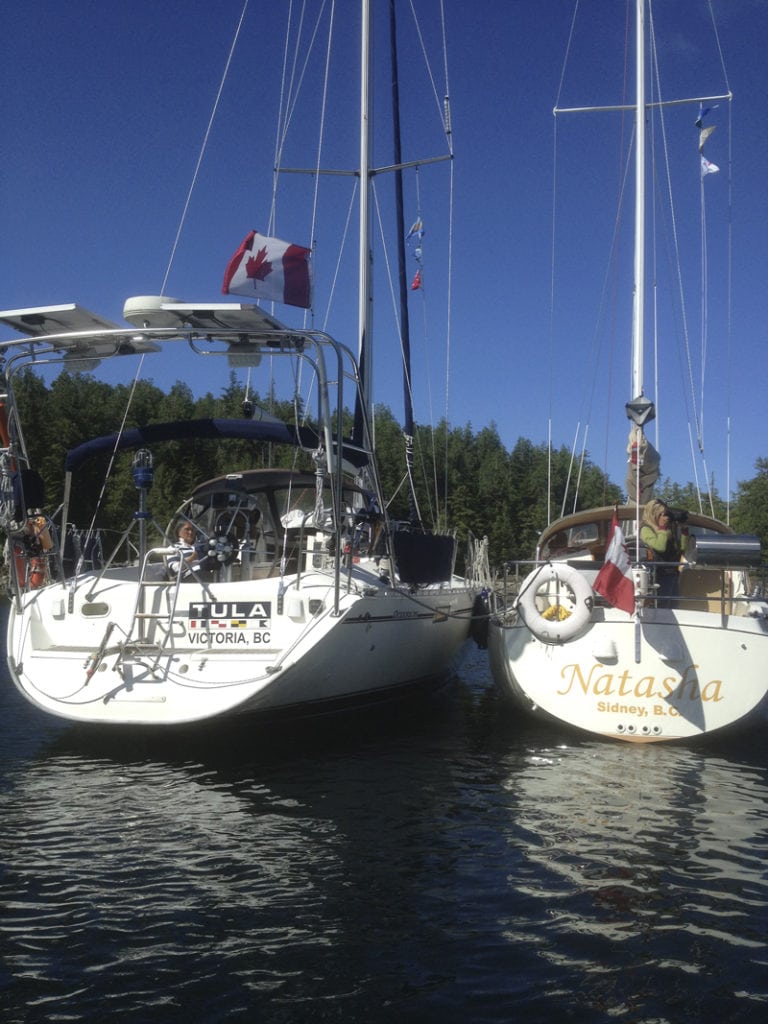
Charts: 3646, 3668, 3670, 3671
In the middle of the stormy winter of 1906, the iron steamship Valencia was driven ashore at Pachena Point. Massive waves dashed the ship and it’s passengers on to the rocky shore with horrific results and the loss of 136 lives. This loss is generally regarded as Vancouver Island’s worst maritime disaster.
It is said that a wrecked ship rests on the ocean bottom for every nautical mile of the west coast of the Island, hence the name ‘The Graveyard of the Pacific’.
As we approached Pachena Point, the weather was a great deal kinder to us than that which the Valencia encountered on January 20, 1906. As we motored beside a small group of transient Orca on calm rolling seas, we said a silent prayer for those who were on the Valencia.
Barkley Sound is a sailor’s delight. Steady winds, safe anchorages, uncrowded waters and great fishing all combined to convince us again to return to one of our favourite cruising destinations. After leaving our base at Tsehum Harbour near Sidney in mid-June, we mainly motored the 120 NM to Bamfield with an overnight stop at Sooke Harbour.
Although we encountered very light NW winds, we planned our departure from Whiffen Spit at Sooke to take advantage of the strong ebb tide out of the Strait of Juan de Fuca and this carried us well past the entrance to Port Renfrew or Port San Juan. The calm weather also enabled our two students to work on the ashore skills section of our Sail Canada Basic Cruising Standard Course (BCS) while underway.

Barkley Sound
Barkley Sound is not the largest of the five major sounds on Vancouver Island's West Coast, but is the most open. At 20 miles wide and 15 miles deep, it is sprinkled with distinct archipelagos separated by wide channels.
On the leeward side of these islands, conditions can be remarkably calm. Serene passages are rich in intertidal life; protected bays, lagoons and long inlets meander deep between the tallest peaks of Vancouver Island. Exposed areas and wave-battered shorelines teem with sea caves, arches and surge channels.
There are two distinct sides to Barkley Sound – the Broken Group and the Deer Group – separated by Imperial Eagle Channel. The Broken Group is a maze of more than 100 islands, islets and rocks scattered over a wide area. Only two communities are located alongside Barkley Sound: Ucluelet to the northwest and Bamfield to the southeast. Port Alberni is at the head of Alberni Inlet, deep in central Vancouver Island.
The warming of the Island interior around Port Alberni causes cool Pacific air to be drawn into the Sound resulting in pea-souper fogs on many mornings. Typically around late morning the fog starts to lift as the sun burns off the moist air.
While we waited for clear air, we worked with our students on their ashore skills course material in the mornings. We then raised anchor and sailed off to another anchorage completing the afloat skills sections of the BCS course in the afternoons. Brisk breezes funnel down the Sound many afternoons making for great sailing conditions.

Jarvis Island Hurricane Hole
After a few weeks cruising and fishing the Sound we had filled Tula’s small freezer with fresh coho fillets. We met up with Bert and crew on the Islander 30 Natasha. Bert convinced us to follow Natasha into the sheltered hurricane hole between Jarvis and Jaques Islands.
Our initial review of our charts scared the heck out of us at the prospect of negotiating the rock-strewn entrance and the route into the cove. However, Bert had been there before and we overcame our initial trepidation and wove our way into the sheltered bay between the two islands.
What a gem of an anchorage! Oysters, hummingbirds galore and good company made for a delightful layover. As there seems to be an absence of July flowers generally in the Sound, just what those hummingbirds feed on is a mystery to us. They showed intense interest in our red Canadian Ensign on Tula’s stern, our red PFD’s, Bert’s hummingbird feeder and anything else red. The air in the little cove simply hummed as the small dynamos continued their never-ending search for sugar.
Pipestem Inlet
We had heard that this Inlet at the NW end of the Sound was well worth a visit and were not disappointed. We found a sheltered spot to drop the anchor behind Bazett Island and after harvesting more oysters, explored the upper reaches of Lucky Creek in our dinghy Tiny Tula.
There is a pretty waterfall up Lucky Creek and we were able to motor up the winding creek to it. Travel up this creek is only recommended either immediately before or after high water. Tiny Tula’s propeller was close to the rocky bottom at times on the return trip out of the Creek.
We enjoyed the quiet solitude, the warm waters and the complete lack of boat traffic in the Inlet and plan to return there again soon.

Port Alberni Yacht Club
We spent two quiet nights at the Port Alberni Yacht Club and recommend a visit there. We were lucky enough to find a good crab hole just around the corner from the Club and caught several Red Rock and Dungeness crabs.
Michelle (aka The Admiral) is our crab processor on board Tula and we regularly watch in wonder as she prepares the crabs we catch. We had yet another fine crab dinner that evening along with Michelle’s gourmet food and accompanying wine. The Admiral is a fabulous cook and we are lucky to have her with us on many voyages.
The Captain’s cooking ability is marginal at best and often our students turn out to be skilled cooks and who can step in and rescue the Captain from further embarrassment in the galley.
